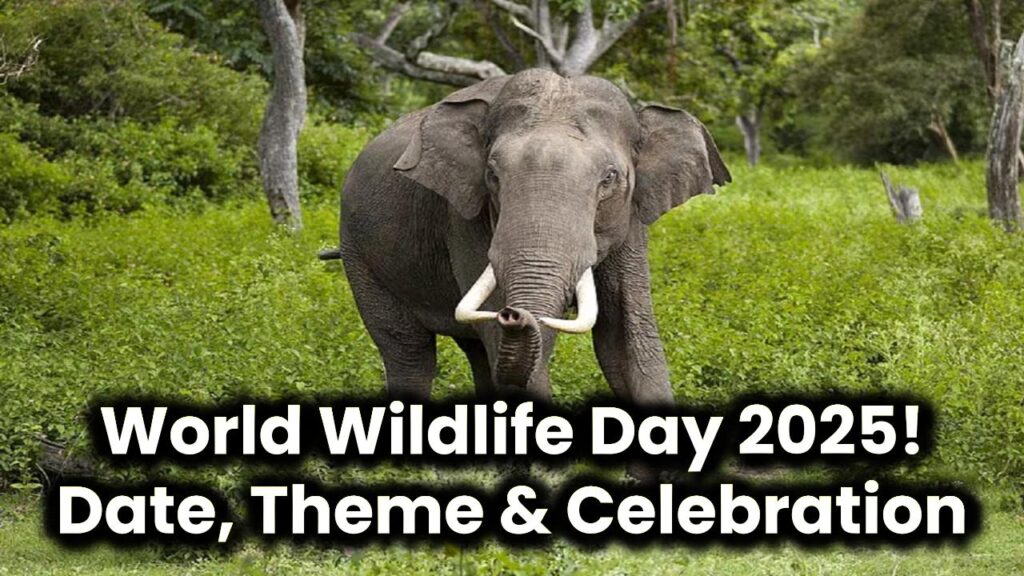
World Wildlife Day 2025 is celebrated on March 3 to raise awareness about the vital role that wildlife plays in sustaining ecosystems, economies, and cultures around the world. This year’s theme, “Wildlife Conservation Finance: Investing in People and Planet,” highlights the importance of securing financial resources to protect biodiversity and ensure a sustainable future for all.
From endangered species to critical habitats, World Wildlife Day serves as a reminder of the urgent need for conservation efforts. Governments, conservationists, businesses, and individuals come together on this day to discuss solutions and take action to safeguard our planet’s natural treasures.
World Wildlife Day 2025
| Aspect | Details |
|---|---|
| Date | March 3, 2025 |
| Theme | “Wildlife Conservation Finance: Investing in People and Planet” |
| Significance | Raises awareness about wildlife conservation and the need for financial investment in biodiversity protection. |
| Global Celebration | Hosted by the United Nations at the Palais des Nations, Geneva, featuring panel discussions, art contests, and more. |
| Official Website | World Wildlife Day |
World Wildlife Day 2025 serves as a powerful reminder of the urgent need to invest in wildlife conservation finance. Protecting nature isn’t just about saving animals—it’s about ensuring the sustainability of our ecosystems, economies, and future generations. Whether through donations, activism, sustainable choices, or community efforts, every contribution counts.
Join the movement on March 3, 2025, and be a part of the global efforts to invest in nature for a better world.
Why World Wildlife Day Matters
Wildlife is crucial to the health of our planet. Over one million species are at risk of extinction, according to the United Nations Environment Programme (UNEP). From forests and oceans to grasslands and wetlands, biodiversity loss threatens food security, water resources, and climate stability.
This day emphasizes the need for action to:
- Prevent habitat destruction caused by deforestation, pollution, and climate change.
- Combat wildlife trafficking and illegal poaching.
- Invest in sustainable development to create a balance between economic growth and conservation.
- Educate people on how they can contribute to conservation efforts.
The 2025 Theme: “Wildlife Conservation Finance” Explained
Conserving wildlife requires substantial financial investment. Governments, organizations, and private sectors must work together to secure funding for conservation projects. Here’s how this theme applies:
1. Public and Private Funding for Wildlife Conservation
Governments allocate funds through protected areas, national parks, and conservation projects. However, private investments from corporations, philanthropists, and green finance initiatives are essential to cover financial gaps.
2. Sustainable Ecotourism
Ecotourism generates billions of dollars annually and directly supports local economies while funding wildlife protection. For example, Africa’s wildlife tourism industry contributes over $29 billion to the economy and supports millions of jobs.
3. Carbon Credit Markets and Biodiversity Bonds
Investors are now funding conservation through carbon credits and biodiversity bonds, where businesses pay to offset their environmental impact by funding reforestation, wildlife corridors, and sustainable farming.
4. Community-Based Conservation Initiatives
Local communities play a crucial role in wildlife conservation. Programs such as community-managed forests and marine reserves have successfully protected biodiversity while improving local livelihoods.
5. Role of Technology in Wildlife Conservation
Technological advancements play a crucial role in wildlife conservation. Drones, artificial intelligence (AI), and GPS tracking are helping conservationists monitor endangered species and detect illegal activities such as poaching. Blockchain technology is being used to improve transparency in conservation funding, ensuring that funds reach the intended projects.
6. Legal Framework and Policy Support
International and national policies shape conservation success. CITES (Convention on International Trade in Endangered Species) regulates the global trade of endangered species, while government policies encourage sustainable practices. Strengthening legal frameworks and enforcing anti-poaching laws can enhance conservation efforts.
How to Celebrate World Wildlife Day 2025
1. Attend Official Events
Join UN’s high-level event in Geneva or participate in live-streamed discussions featuring conservationists, policymakers, and industry leaders.
2. Support Conservation Organizations
Donate to reputable organizations such as:
- World Wildlife Fund (WWF) (www.worldwildlife.org)
- International Union for Conservation of Nature (IUCN) (www.iucn.org)
- Wildlife Conservation Society (WCS) (www.wcs.org)
3. Participate in Local Activities
- Volunteer at a wildlife rehabilitation center.
- Organize a clean-up drive in nature reserves.
- Join educational workshops and wildlife photography contests.
4. Raise Awareness on Social Media
Use #WWD2025, #WildlifeConservationFinance, and #InvestInNature to spread the message and encourage action.
5. Make Sustainable Choices
- Avoid products made from endangered species.
- Support brands that practice ethical and sustainable sourcing.
- Reduce waste and plastic consumption to protect marine life.
6. Educational Programs for Schools
Schools can integrate wildlife conservation into their curriculum by organizing workshops, wildlife-themed projects, and field trips to nature reserves. Encouraging young minds to engage in conservation can lead to long-term positive impacts.
FAQs About World Wildlife Day 2025
1. Why is World Wildlife Day Celebrated on March 3?
World Wildlife Day was established by the United Nations General Assembly (UNGA) in 2013 to coincide with the signing of the Convention on International Trade in Endangered Species of Wild Fauna and Flora (CITES) in 1973.
2. How Can Businesses Contribute to Wildlife Conservation?
Businesses can contribute by adopting sustainable supply chains, funding conservation projects, reducing carbon footprints, and supporting eco-friendly tourism.
3. What Are Some Endangered Species That Need Immediate Protection?
- Amur Leopard (Fewer than 100 remain in the wild)
- Vaquita Porpoise (Critically endangered, with less than 20 left)
- Javan Rhino (Approximately 80 individuals remaining)
- Pangolins (The most trafficked mammal globally)
4. How Can Individuals Make a Difference?
- Educate yourself and others about wildlife conservation.
- Support ethical tourism and wildlife-friendly products.
- Reduce carbon footprints by adopting sustainable habits.
5. What Are Some Global Success Stories in Wildlife Conservation?
- Tigers: Populations have increased in India, Nepal, Bhutan, and Russia due to stringent conservation policies.
- Giant Pandas: Upgraded from “Endangered” to “Vulnerable” by the IUCN.
- Marine Protected Areas: Several nations have expanded ocean sanctuaries to protect marine life.










